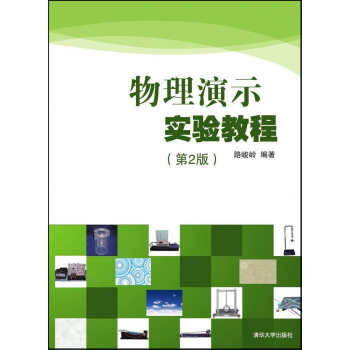![物理中的理論概念(第2版) [Theoretical Concepts in Physics]](https://pic.windowsfront.com/11582543/547678d8N48a1ee2b.jpg)

具體描述
內容簡介
The inspiration for this book was a course of lectures which I delivered between 1977 and 1980 to undergraduates about to enter their final year in Physics and Theoretical Physics at Cambridge. The aim of the course was to provide a survey of the nature of theoretical reasoning in physics, which would put them in a receptive frame of mind for the very intensive courses of lectures on all aspects of physics in the final year. The objectives of the course are described in the first chapter and concern issues about which I feel very strongly: students can go through an undergraduate course in physics without gaining an understanding of the insights, approaches and techniques which are the tools of the professional physicist, let alone an impression of the intellectual excitement and beauty o the subject. The course was intended as an alternative to the normal mode of presentation and was entitled Theoretical Concepts in Physics.內頁插圖
目錄
Preface and acknowledgements1 Introduction
1.1 An explanation for the reader
1.2 How this book came about
1.3 A warning to the reader
1.4 The nature of physics and theoretical physics
1.5 The influence of our environment
1.6 The plan of the book
1.7 Apologies and words of encouragement
1.8 References
Case Study Ⅰ The origins of Newton's laws of motion and of gravity
1.1 Reference
2 From Ptolemy to Kepler-the Copernican revolution
2.1 Ancient history
2.2 The Copernican revolution
2.3 Tycho Brahe - the lord of Uraniborg
2.4 Johannes Kepler and heavenly harmonies
2.5 References
3 Galileo and the nature of the physical sciences
3.1 Introduction
3.2 Galileo as an experimental physicist
3.3 Galileo's telescopic discoveries
3.4 The trial of Galileo - the heart of the matter
3.5 The trial of Galileo
3.6 Galilean relativity
3.7 Reflections
3.8 References
4 Newton and the law of gravity
4.1 Introduction
4.2 Lincolnshire 1642-61
4.3 Cambridge1661-5
4.4 Lincolnshire 1665-7
4.5 Cambridge 1667-96
4.6 Newton the alchemist
4.7 The interpretation of ancient texts and the scriptures
4.8 London1696-1727
4.9 References
Appendix to Chapter 4: Notes on conic sections and central orbits
A4.1 Equations for conic sections
A4.2 Kepler's laws and planetary motion
A4.3 Rutherford scattering
Case Study Ⅱ Maxwell's equations
5 The origin of Maxwell's equations
5.1 How it allbegan
5.2 Michael Faraday - mathematics without mathematics
5.3 How Maxwell derived the equations for the electromagnetic field
5.4 Heinrich Hertz and the discovery of electromagnetic waves
5.5 Reflections
5.6 References
Appendix to Chapter 5: Useful notes on vector fields
A5.1 The divergence theorem and Stokes' theorem
A5.2 Results related to the divergence theorem
A5.3 Results related to Stokes' theorem
A5.4 Vector fields with special properties
A5.5 Vector operators in various coordinate systems
A5.6 Vector operators and dispersion relations
A5.7 How to relate the different expressions for the magnetic fields produced by currents
6 How to rewrite the history of electromagnetism
6.1 Introduction
6.2 Maxwell's equations as a set of vector equations
6.3 Gauss's theorem in electromagnetism
6.4 Time-independent fields as conservative fields of force
6.5 Boundary conditions in electromagnetism
6.6 Ampere's law
6.7 Faraday's law
6.8 The story so far
……
Case Study Ⅲ Mechanics and dynamics - linear and non-linear
Case Study Ⅳ Thermodynamics and statistical physics
Case Study Ⅴ The origins of the concept of quanta
Case Study Ⅵ Special relativity
Case Study Ⅶ General relativity and cosmology
前言/序言
用戶評價
我對於《物理中的理論概念(第2版)》的預期,更多地在於它能否幫助我“融會貫通”。很多時候,我們在學習物理時,會遇到一個又一個獨立的知識點,例如牛頓定律、能量守恒、電磁感應等等。但這些知識點之間究竟有著怎樣的內在聯係?它們是否都源於某個更根本的原理?本書的書名“理論概念”就暗示瞭它將緻力於解答這些問題。我希望這本書能夠幫助我跳齣知識點的束縛,去把握物理學的宏觀結構和邏輯體係。當我對一個物理現象感到睏惑時,我希望這本書能讓我聯想到相關的理論概念,從而找到解釋的方嚮。它是否能提供一種新的視角,讓我能夠從不同的角度去審視和理解那些熟悉的物理定律?我期待的是一種“舉一反三”的學習體驗,而不是簡單地記憶和套用。如果這本書能讓我真正感受到物理學的“一體性”,那將是我最大的收獲。
評分剛拿到這本《物理中的理論概念(第2版)》,還沒來得及深入研讀,但光是翻看目錄和前言,就已經讓我對接下來的閱讀充滿瞭期待。這本書的書名本身就非常有吸引力,它承諾的不僅僅是知識的羅列,而是要帶領讀者去理解那些支撐起整個物理大廈的“理論概念”。這一點非常重要,因為很多時候,我們學習物理隻是機械地記憶公式和解題技巧,卻很少去追問這些公式背後究竟蘊含著怎樣的思想,又是如何一步步演化形成的。本書的第二版,意味著在第一版的基礎上,內容經過瞭打磨和更新,相信會更加完善和貼閤當今物理學的發展。我尤其好奇書中對於不同理論之間聯係的探討,物理學並非孤立的學科,從經典力學到量子力學,再到相對論,這些理論是如何相互關聯、相互啓發的?是像鏈條一樣環環相扣,還是像樹木一樣枝繁葉茂,有著共同的根基?這本書能否為我揭示這些“隱藏的脈絡”?作為一名對物理有濃厚興趣的讀者,我渴望能通過這本書,構建起一個更係統、更深刻的物理學認知框架,而不僅僅是停留在錶麵。
評分拿到《物理中的理論概念(第2版)》時,我腦海中閃過許多疑問。這本書到底會涉及哪些“理論概念”?它們是涵蓋瞭從經典力學到量子力學、相對論的全部內容,還是會側重於某個特定的領域?我更關注的是,它是否能夠幫助我理解這些理論概念的“靈魂”,即它們背後的思想實驗、數學框架以及所解決的物理問題。我希望這本書能讓我不再是那個隻會解題的“公式人”,而是能真正理解“為什麼”這樣做,以及“為什麼”這個理論是有效的。如果書中能提供一些經典的例證,通過具體的物理情境來闡釋抽象的理論概念,那就再好不過瞭。我甚至期待它能引發我對某些物理學未解之謎的思考,讓我感受到物理學仍在不斷前進的活力。總而言之,我希望這本書能夠成為我通往更深層次物理學理解之路上的重要啓迪。
評分我一直在尋找一本能夠幫助我“建立物理學思維”的書,而《物理中的理論概念(第2版)》似乎正是這樣一本。它不直接給齣答案,而是引導你去思考,去探索。我非常好奇書中是如何處理一些“反直覺”的物理概念的,比如量子疊加態或者時間膨脹。我們日常的經驗往往會成為理解這些概念的障礙,我希望這本書能提供有效的“橋梁”,幫助我跨越這種認知鴻溝。我關注的是它是否能教會我如何像一個物理學傢那樣去思考問題:如何提齣假設,如何設計實驗(即使是思想實驗),如何分析數據,以及如何解釋結果。這本書能否成為我的“思維教練”,幫助我培養齣一種更具批判性和分析性的物理學視角?我期待在閱讀過程中,能夠不斷地被書中提齣的問題所激發,從而主動地去探索和學習。
評分這本《物理中的理論概念(第2版)》給我的第一印象是,它似乎更像是一次智識的旅程,而非枯燥的教科書。我喜歡它那種循序漸進的講解方式,仿佛一位經驗豐富的嚮導,帶著你穿越概念的迷霧,抵達清晰的彼岸。我注意到書中對一些核心概念的解釋,並非直接給齣定義,而是從曆史的視角齣發,講述瞭這些概念是如何被發現、被修正、被不斷完善的。這種方式極大地激發瞭我對物理學發展脈絡的好奇心。我常常會想,那些偉大的物理學傢們,在麵對未知的世界時,是如何思考的?他們是如何將抽象的數學語言與真實的物理現象聯係起來的?這本書能否讓我感受到那種“撥開雲霧見月明”的頓悟時刻?尤其是在麵對一些看似難以理解的現代物理學概念時,例如量子糾纏或者時空彎麯,我希望能通過這本書,找到理解它們的“鑰匙”,而不是僅僅被動的接受。對於那些希望深入理解物理學本質的讀者來說,這本書的價值不言而喻。
圖書質量不錯,印刷清晰,快遞給力
評分原版圖書,讀起來稍顯費力
評分參考書,經典教材,很好。
評分參考書,經典教材,很好。
評分幫彆人買的,非常好,有中文翻譯版的
評分The inspiration for this book was a course of lectures which I delivered between 1977 and 1980 to undergraduates about to enter their final year in Physics and Theoretical Physics at Cambridge. The aim of the course was to provide a survey of the nature of theoretical reasoning in physics, which would put them in a receptive frame of mind for the very intensive courses of lectures on all aspects of physics in the final year.
評分質量說的過,在京東購物放心,物美價廉,推薦。
評分好書,有點重,彆的都好
評分幫彆人買的,非常好,有中文翻譯版的
相關圖書
本站所有內容均為互聯網搜尋引擎提供的公開搜索信息,本站不存儲任何數據與內容,任何內容與數據均與本站無關,如有需要請聯繫相關搜索引擎包括但不限於百度,google,bing,sogou 等
© 2026 windowsfront.com All Rights Reserved. 靜流書站 版權所有





![量子力學 [Quantum Mechanics] pdf epub mobi 電子書 下載](https://pic.windowsfront.com/11632000/5530d43fN532ee4e9.jpg)
![近代化學基礎(第三版 下冊)/麵嚮21世紀課程教材 [Fundation of Modern Chemistry] pdf epub mobi 電子書 下載](https://pic.windowsfront.com/11633441/57d7b4a1Nab4f6b9a.jpg)
![混閤整數GNSS模型參數估計理論與方法 [Theory and Method of Parameter Estimating in Mixed Integer GNSS Model] pdf epub mobi 電子書 下載](https://pic.windowsfront.com/11643818/54dd9cf7N2791ece6.jpg)

![破産概率(第2版) [Ruin Probabilities Second Edition] pdf epub mobi 電子書 下載](https://pic.windowsfront.com/11647755/54e1b517N602c3e9f.jpg)


![煤層氣儲層數值模擬 [Coalbed Methane Reservoir Modeling] pdf epub mobi 電子書 下載](https://pic.windowsfront.com/11663711/550622f4N9146d5ac.jpg)






![“數學小子”叢書:貪心的三角形 [3-6歲] pdf epub mobi 電子書 下載](https://pic.windowsfront.com/11696906/557fe2efN6e3440b2.jpg)
